With all the marketing nonsense surrounding sunglasses, its easy to forget that a good pair of polarized lenses is a tool, as essential to sailors as a good knife.
The principal purpose of sunglasses is to prevent ultraviolet rays, implicated in eye diseases ranging from cancer to cataracts, from reaching our eyes. Both UVA (400-320 nanometers) and UVB (320-290 nanometers) are harmful, but UVB is considered the most damaging. The American National Standards Institute (ANSI) requires non-prescriptive sunglasses to meet a series of standards under ANSI Standard Z80.3. Unfortunately, the UV transmission limits are fairly loose for non-prescriptive eyewear, enforcement is poor, and worthless counterfeits abound. The best way to ensure you’re getting the protection you need is to choose lenses that block at least 99-percent UVB and 95-percent UVA and to buy from a reputable dealer.

Practical Sailor
What We Tested
For the purposes of this test, Practical Sailor concentrated on another key function of sunglasses for sailors: reducing reflections on the waters surface so the wearer can better judge the bottom depth by sight. This pared the field down to sunglasses with glare-cutting polarized lenses. Keenly aware that a comprehensive test was impractical, we assembled 25 different polarized glasses representing a cross-section of whats available in the high, mid-range, and low-price categories.
The list included some of the big names in the industry like Oakley and Maui Jim, as well as companies that market eyewear specifically to sailors like Hobie, Kaenon, Gill, and Harken. We also included some popular fishing glasses and some inexpensive frames, including a pair of $14 glasses picked up at a gas station and $8 childrens shades from a mega-retailer.
The main goal of the project was to set some firm criteria for selecting sunglasses for eyeball navigation and to resolve that nagging question: Do we really need to spend $200 to obtain good quality lenses. (Spoiler alert: The answer is no.)
How We Tested
Testing began in the field as six volunteers with good uncorrected vision and different face types subjectively compared the glasses in various on-the-water tests. To judge each lens usefulness for eyeball navigation, testers observed a variety of bottom features (grass, sand, rock) in depths from 3 to 40 feet. Testing took place under partly sunny and overcast conditions at midday.
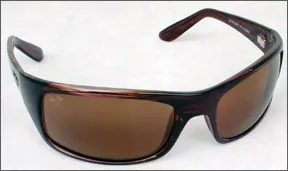
The “distant shoal” test, which required spotting a sandy shoal at three-quarters of a mile under cloudy skies, proved to be a good benchmark. A few glasses made it easy to distinguish the shoal, but with most it was invisible.
Testers also independently evaluated the glasses for fit, peripheral vision, comfort, magnetism, smudge resistance, corrosion resistance, and the ability to prevent fogging and shed water. The glasses were also compared when viewing a handheld GPS and a chart. Anti-reflective coatings, which help ghost images reflected on the inside of the lenses, also were checked. Style was not evaluated.
Glasses that excelled in the field tests and three pairs that fell short were sent to Dr. Karl Citek at Pacific University College of Optometry in Forest Grove, Ore. for analysis. (Full disclosure: Dr. Citek is co-inventor of patents licensed by Nike, but receives no compensation, royalties, etc.) The “Lens” scores in the Value Guide on page 8 show results in the field and the lab. The following are some of the optical tests carried out:
Lens warpage: This meridional lens “flex” is often caused when oversized lenses are squeezed into their frames. This helps lenses stay in their frames, but the distortion can lead to tired eyes.
Prismatic effect: Imperfect, curved lenses tend to bend the light when you are not looking directly through the center of the lens. Polycarbonate lenses are particularly prone to this. Unless you want to hit a Tim Wakefield knuckle ball, you can probably live with it.
Resolution: A standard test using closely spaced vertical and horizontal lines is used to evaluate the “sharpness” of objects when viewed through a lens.
Luminosity transmission: Testers used a spectrophotometer to measure the total amount of visible light as well as the amount of light in the various wavelengths (including UVA and UVB) transmitted through each lens.
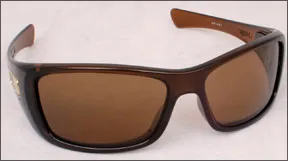
Tint: This is the dominant tint of the lens, not to be confused with the colored mirror flash coating applied to the outside of the lens. The latter reduces light transmission and conceals your eyes but generally does not change the tint.
What We Found
On the water, sunglasses with brown tints (the brochures call it “copper”) performed better than those with basic grey lenses. Amber lenses scored well in the low-light testing.
The overall favorites were brown- or amber-tinted lenses that allowed between 8-percent and 14-percent light transmission and showed exceptional resolution. This included lenses from Costa Del Mar, Oakley, Maui Jim, Harken, and Kaenon.
Claimed specs for total light transmission were often markedly lower than those found in the lab. For example, the Kaenon specifies a 12-percent light transmission for its C-12 lens, yet the lab tests showed about 8.5 percent.
Although brown lenses scored highest in the eyeball navigation exercises, grey lenses often are preferred for everyday use because of their ability to accurately show “true” colors. A few makers did not submit brown lenses; we suspect they would have scored higher in our comparison had they done so.
With regard to frames, testers favored wraparound designs that prevented light from entering at the sides and bottom. Snug frames and a good hat are essential to reducing UV exposure. Soft rubber, “no-slip” bridge grips and ear pieces were popular, but they also pick up sunscreen stains and tend to become gummy during their lifetime. Ideally, any such rubber components would be easily replaceable. Not all glasses fit well with hats (Oakley-style temple grips wouldnt stay put beneath our favorite Mount Gay Rum cap), something buyers should check.
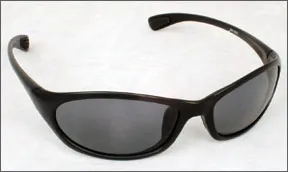
What follows are capsule observations on the five favorite sunglasses for eyeball navigation as well as some short profiles of representative types. For more on what to look for in sunglasses, see the “Buyers Guide” on page 7.
Glass Lenses
Three of the manufacturers sent us samples with glass lenses: Costa Del Mar, Hobie, and Maui Jim. Although the tested glass lenses met or exceed the accepted ANSI standards, opticians do not recommend glass for sports eyewear because they do not absorb impact well. Generally, glass-lens vendors tout the superior optical performance and scratch-resistance of glass and downplay the cons of added weight and the potential for breaking. The lab-tested glass lenses stood out for their excellent scores, but some of the non-glass lenses did as well or better overall. Practical Sailor does not recommend glass lenses for racing or small boat sailing.
Costa Del Mar Blackfin 580 GLS
Costa Del Mar touts patented lenses that absorb the yellow light in the 580 nanometers wavelength, although several other basic brown-tinted lenses yielded similar spectrophotometry. The Costas were unanimously praised for their ability to distinguish bottom features, particularly under overcast skies. One of the most notable effects of these glasses is that red colors “pop,” making it easy to pick up red markers on the water or chart.
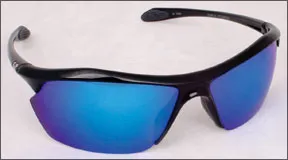
The Costas and the Harkens were the only pairs with a perfect score in resolution testing (each had one perfect lens), although the Costas had more of astigmatism and horizontal prism distortion than any other on-the-water favorite. The Blackfin frames provided great UV protection, but only Fair peripheral vision.
Costa Del Mar told Practical Sailor that it had discovered a batch of its 400 lenses that were more susceptible to delamination problems, but this had been corrected, and it was not aware of any similar problems in the 580 lenses.
Bottom line: These were the best glasses for eyeball navigation, and on that basis, they earn Best Choice. Wed opt for different frames with more peripheral vision.
Hobie Bayside/Copper Lens
Testers looked at three lenses and frame types from Hobie. All rated Very Good to Excellent in the field, with the Bayside frames scoring highest. The Hobies lens coating sheds water better than most, but none of the tested glasses that touted hydrophobic coatings were immune to saltwater spray or smudges.
The Hobie copper with green-mirror lenses were excellent in bright sunlight. Their quality optics stood out in the lab, but the lenses blocked too much light to pick up bottom details well. This also posed a problem when viewing LCD screens. The Bayside frames-featuring spring hinges, very little light leakage, and Excellent peripheral view-were a favorite among male testers, but some women found them too big.
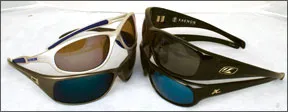
Bottom line: These offer good optical quality and an excellent frame. The dark lenses would serve well offshore, but for eyeball navigation, we would opt for Hobies copper lens with no mirror.
Maui Jim Peahi/HCL Bronze lens
All three Maui Jim samples had glass lenses and all rated highly on the water. The pick of the litter, the Peahi frame style with a bronze lens, scored equally well in the lab. Less than a .01 diopter change in the optical power was found in either lens, exceptional for sunglasses.
These were the heaviest glasses among our finalists. The spring-hinge frames offered only Fair peripheral view, but eye protection was excellent. They blocked a bit more light that the Costa Del Mars and ranked only slightly behind them on the water. Resolution scores were high, although some horizontal prismatic effect was noted in one lens.
Bottom line: The Maui Jim Peahis with HCL Bronze lenses had excellent optics and should serve as a durable tool for eyeball navigation. Downsides are the price, potential breakage of glass lenses, and weight.
Plastic Lenses
Plastic lenses greatly outnumbered glass lenses in the comparison. Samples were either acrylic, polycarbonate, C-39, or SR-91. (See “Buyers Guide for more on these materials.) While the plastic lenses generally scored below glass on the water, several plastic lenses, including those from Kaenon, Oakley, and Harken, did as well or better than some glass lenses in some lab tests. The cheapest kids plastic lenses still blocked more than 99-percent UVA and UVA. Plastic lenses with flash mirror coatings generally did worse in overcast daylight and LCD screen tests.
Oakley Hijinx/copper lens
Oakley lists its “high-definition” polycarbonate lenses as copper, but they were closer to amber, presenting the highest light transmission rating in the lab test (about 14 percent) among the finalists. They ranked consistently in the top four for eyeball navigation. The pair had very little distortion away from the center of the lens (prismatic effect), rare among polycarbonate lenses. The Hijinx frame provided excellent protection and was popular among female testers, but peripheral vision was a notch below the best.
Bottom line: Optically, these were the best polycarbonate lenses, showing none of the prismatic effect found in the Harkens, their nearest on-the-water competitor. Whether this is worth the extra $100 depends on your budget and how you plan to use them.
Harken Gale/Brown lens
In the field and the lab, these amber polycarbonate lenses matched up with the more expensive Oakley, Maui Jim, Kaenon, and Costa Del Mar glasses. The anti-reflective coating on the inside of the Harkens was better than that on similarly priced glasses. The wraparound nylon frames were unexciting but functional, seemingly not as strong at typical failure points (hinges, bridge, and ear pieces) as some pricier glasses, but rugged enough.
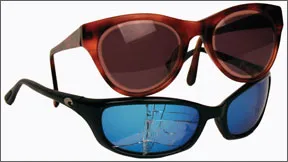
Bottom line: In the field and in the lab, the Harkens compared favorably to some of the most expensive glasses in our test. They are indisputably our Budget Buy in this category.
Gill Gemini
Gill sent us its youth Firefly (blue lens), unisex Classic (smoke lens), and womens Gemini glasses (copper lens), all with acrylic Polaroid lenses. Gills newest glasses have improved PTX4000 lenses, which were released after our test. All of the glasses stood out for their lightweight floating frames and comfortable fit. The Gemini glasses with copper lenses fared the best of the three in the eyeball navigation test. In the lab, the thin acrylic lenses in the Geminis allowed for very little prismatic distortion, but they had notable warpage.
Bottom line: Buoyancy could not lift these above others in their class.
Kaenon Hard Kore/C-12 lens
Kaenon is the only manufacturer that offers lenses made of SR-91, a proprietary plastic that is stronger and has better abrasion resistance than polycarbonate. On the water, these glasses with brown C-12 lenses provided a good balance between light transmission and tint, proving capable of defining shoalwater in sun and shadow.
The C-12 lenses blocked slightly more light than the Costas and Maui Jims, and this was noticeable when looking at an LCD screen and navigating in overcast conditions. The left lens showed some minor prismatic effect. The frames were durable and offered excellent protection, but some testers noted that the Hard Kores broad ear pieces put more pressure on the ears than other premium glasses.
Bottom line: With rugged frames and very good optics, the Kaenons may be worth the price for those who are plagued by scratched lenses and don’t want glass.
Typhoon Gale Force
We sent these $60 shades from West Marine to the lab as a representative of mid-priced fishing glasses. The frames were very comfortable and provided good protection. Although the lenses blocked 100-percent UV and had similar spectral characteristics as the on-the-water favorites, they rated low in the field. The reason became clear in the lab, where the lenses showed significant warpage, prismatic effect, and mediocre resolution.
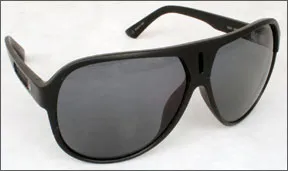
Bottom line: You can do much better in this price range.
Boll Spinners
Testers liked the comfortable wrap-around frame with side windows that preserved peripheral vision. On-the-water tests, however, found the darker lenses could not compete with others in shoalwater navigation. (Other lenses are available.) The lab yielded mediocre performance numbers.
Bottom line: With a high price and mediocre performance, the Spinners with “Offshore Blue” (grey) lenses fell short of expectations.
Others
Several manufacturers sent a selection of sunglasses that didnt rate high enough in the field to earn a trip to the lab, but deserve mention here. Specifications and ratings for field tests for some of these glasses appear in the Value Guide on page 8. These manufacturers may offer lenses and styles that better fit our criteria, but the ones they submitted did not.
Dragon Alliance E.C.O.: These glasses “inspired” by surfing icon Rob Machado are touted as being made entirely of recycled material. The testers liked the eco-approach, but the retro-style frames leaked light and the polycarbonate lenses were too dark to do well in the field tests.
Ocean Waves: Prominent at many boat shows, this Florida sunglasses maker sent us several pairs, nearly all of which had grey lenses with flash mirror coatings. As mentioned, no lenses with these features rated very strongly in the field testing. Ocean Waves best performing entry was a brown lens with a green flash coating from their Jack Nicklaus line.
Sea Specs:These $50 goggle-type glasses have a vocal following on the Internet as watersports glasses. While they were comfortable, testers found them too dark for eyeball navigation. The brown polarized Sunset Specs would presumably do better.
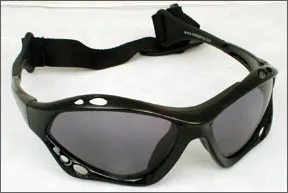
Nike Haul: These comfortable, lightweight glasses had an interesting frame design with interchangeable lenses. They were among the better grey lenses on the water.
Under-Armour Zone XL: These comfortable sports glasses offered excellent protection, but were held back by their dark grey tint and reflective coating.
Gas-station specials: These comfortable, lightweight glasses with acrylic lenses scored fair on the water, and they blocked 99.9-percent UVA and 99.8-percent UVB.
Polar Optic Solar 3 Antics: This aluminum frame model did not rate high, but a pair of fitover Polar Optics with brown lenses scored well on the water.
Conclusion
An investment in good sunglasses will pay off when your arrival at a narrow, unmarked pass coincides with grey, flat light. Generally, the higher-priced sunglasses in this comparison brought better optics, more rugged frame construction, more size options, and stronger warranty policies. However, one of the highest-rated pairs was not nearly the most expensive, so its clear that price alone is not a good benchmark.
Based on our testing, we’d recommend cruising sailors have at least two sets of polarized sunglasses. A pair of high-quality, brown-tinted shoal spotters should stay on the boat, while a pair of all-purpose grey lenses can be reserved for everyday use. Aim for light transmission of 10 percent to 14 percent, but note that in our test, lenses tended to block more light than the specs stated.
Lens material selection will depend on how you use (abuse, or lose) your glasses, although wed stay away from cheap acrylic lenses that easily pop out.
If your budget allows, or you have sensitive eyes, think about adding a pair of darker tinted glasses for offshore. But remember, glasses with less than 8-percent light transmission arent considered safe for driving. A pair of inexpensive high-transmission (14 to 18 percent) amber lenses can serve as boat backups or for low-light conditions. Frames need to be comfortable and secure and should minimize or eliminate light leaks. Otherwise, all that UV protection is for nothing.
In this comparison emphasizing eyeball navigation, lenses from Costa Del Mar, Harken, Oakley, Maui Jim, and Kaenon scored highest. They could be ranked in that order, although scoring was close for the last four. All except the Harkens can be made to fit most prescriptions. (Again, we should point out that brown or copper lenses from the other top performers in the lab likely would have scored higher on the water than the lenses tested.)
If we had the dough, wed spring for the Costas for our reef-spotting tool, but wed look for a frame style with better peripheral view. A pair of Oakleys or Kaenons would make excellent everyday sailing shades. The Oakleys low prismatic effect will appeal to foredeck crew or small-boat racers. If we werent so broke or absent minded, a pair of glass-lens Maui Jims or Hobies (with more light transmission than the ones tested) would be great leisure shades.
For our money though, a couple pairs of Harkens with polycarbonate lenses, one with brown tint for the boat, one with grey tint for the road or offshore are very tough combination to beat.



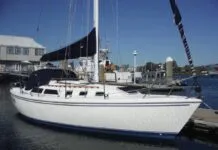

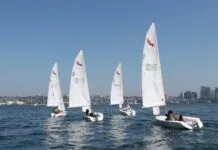



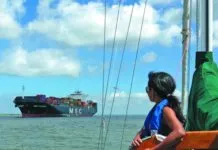
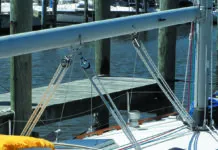

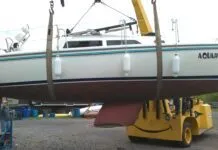
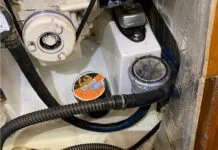
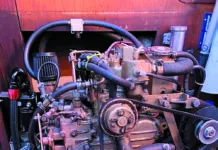

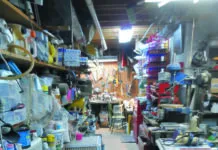















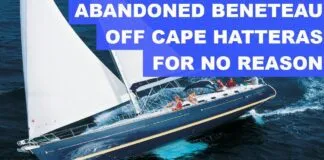



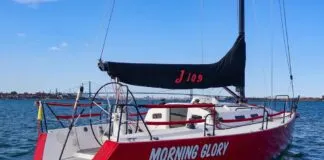
Gidday P-S I am curious if anyone has experience with belaying (prism type) glasses if one has difficulty looking up for extended periods (trimming sails, windex etc) . These glasses are used and designed by climbers , any crossover ?
Pete Rissi ( Wiarton , Canada )